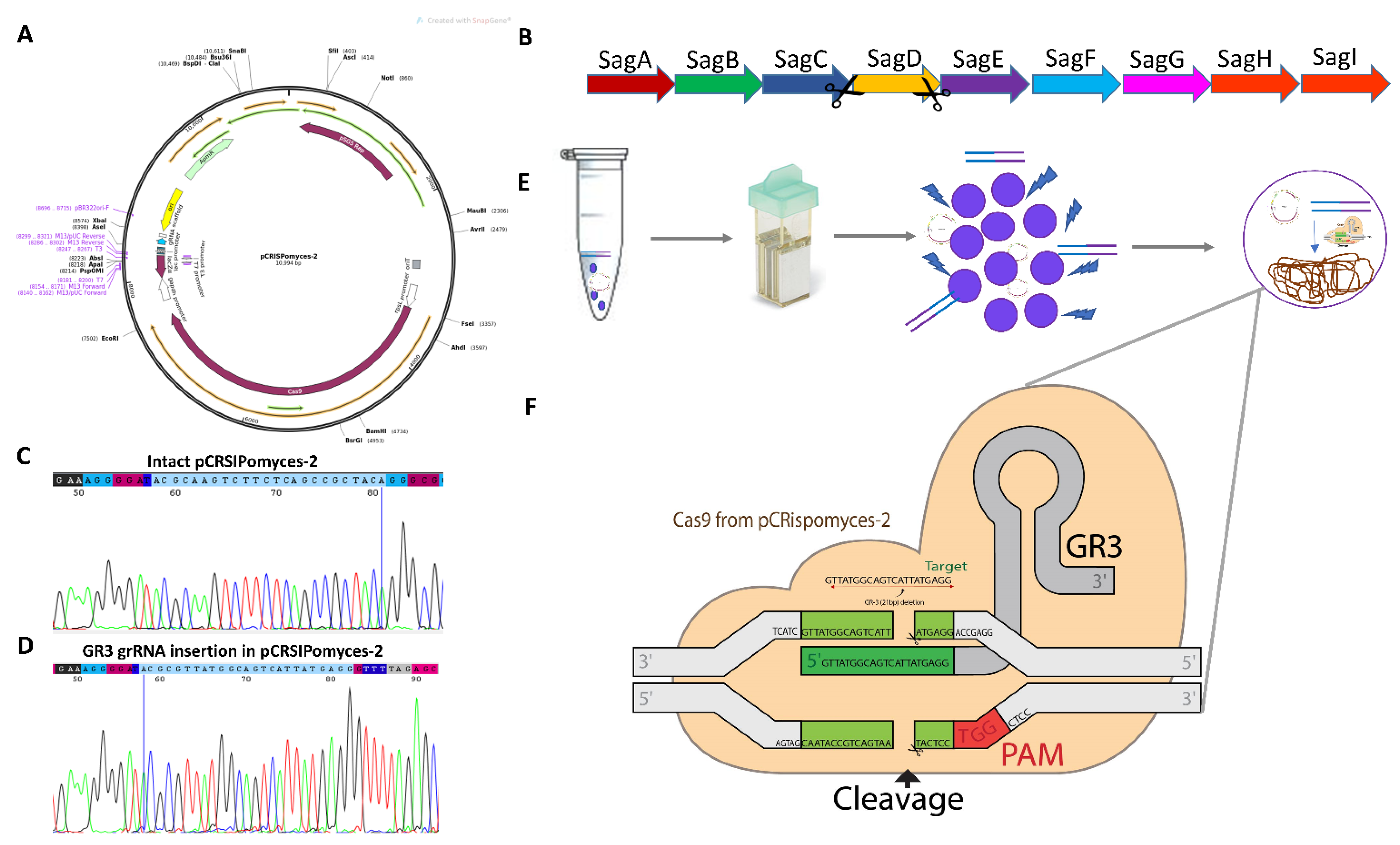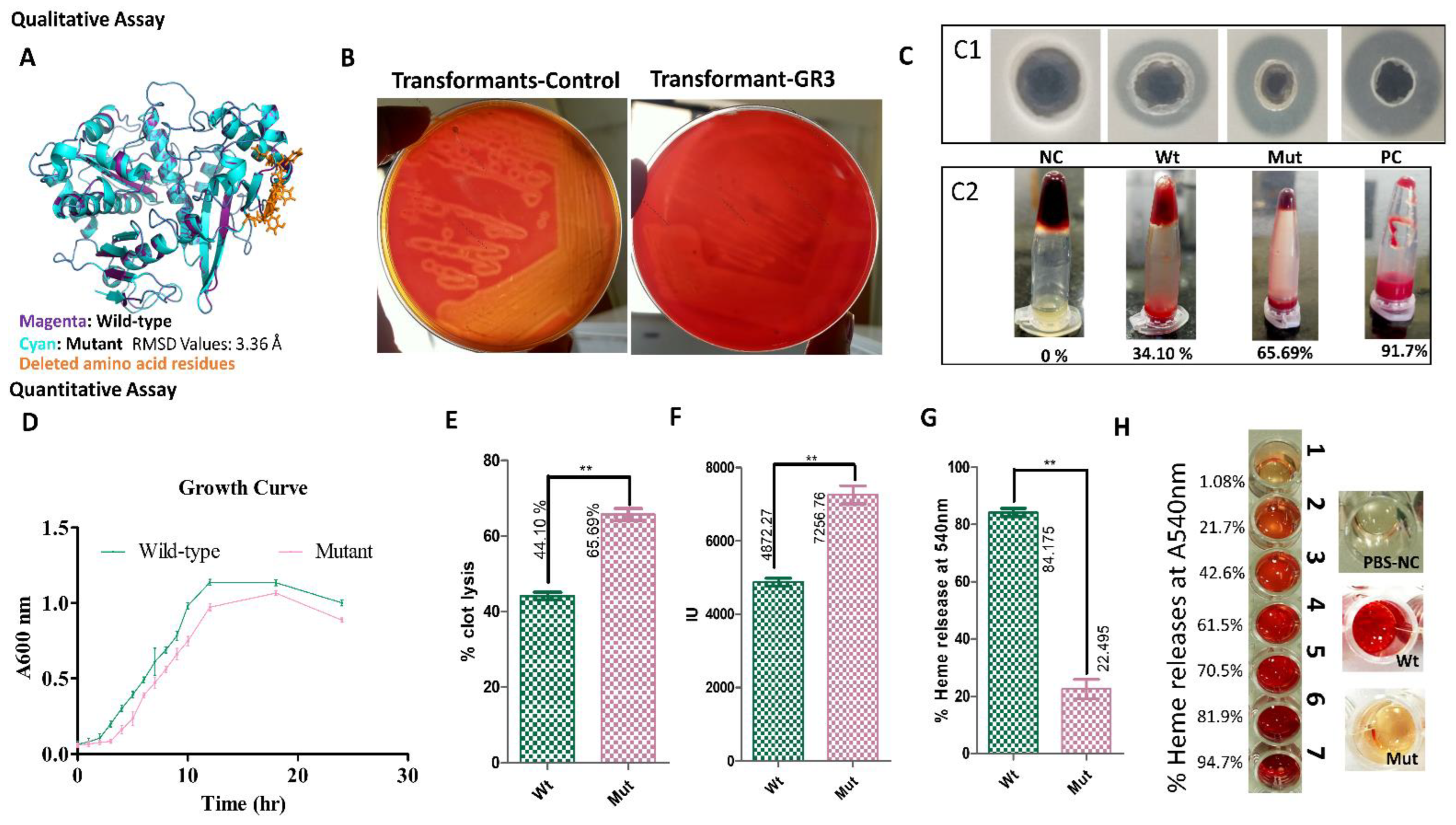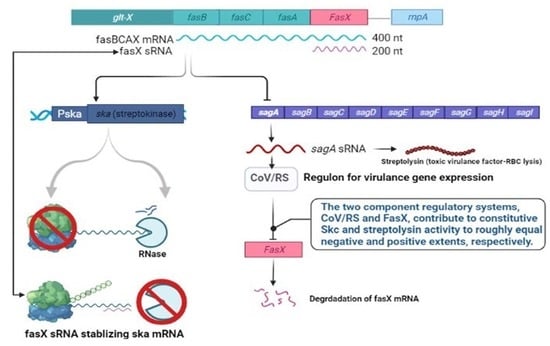CRISPR-Cas9 Mediated Knockout of SagD Gene for Overexpression of Streptokinase in Streptococcus equisimilis
Abstract
:1. Introduction
2. Results
2.1. Streptolysin Knockout Strategy Using -PCRISPomyces-2
2.2. Change in the Expression Profile of Streptokinase and Streptolysin
2.3. Change in Streptokinase Protein Expression Profile
3. Discussion
4. Materials and Methods
4.1. Microorganisms, Plasmids, and Reagents
4.2. Media and Culture Conditions
4.3. Design and Construction of sgRNAs Plasmids
4.4. Transformation of Constructed Plasmid into E. coli Top 10F’ and S. equimilus
4.5. Screening of Knocked out Clones Using Sequencing and Hemolysis Activity
4.6. Real-Time PCR for Gene-Expression Profiles
4.7. MALDI-TOF/MS for Confirmation of Streptokinase Expression on SDS-PAGE
4.8. Zymography
4.9. Streptokinase Blood Clot Lysis and Fibrin Plate Assay
4.10. Streptolysin Heme Release Assay
4.11. SagBCD Complex Computational Modeling
4.12. Growth Curve for Wild-Type and Mutant Strains
5. Conclusions
6. Highlights
- Streptokinase is an important enzyme used as a drug for the breaking down of blood clotting.
- The S. equisimilis strain was used for the expression of streptokinase.
- The CRISPR-Cas9 system was employed for genome editing of the SagD gene
- We observed a 13.58-fold higher streptokinase expression in the knocked out strain compared to the wild-type strain, and the fold change in enzyme activity was 1.48 (t-test, p > 0.05).
Supplementary Materials
Author Contributions
Funding
Institutional Review Board Statement
Informed Consent Statement
Data Availability Statement
Acknowledgments
Conflicts of Interest
References
- Diwedi, S.K.; Hiremath, J.S.; Kerkar, P.G.; Reddy, K.N.; Manjunath, C.N.; Ramesh, S.S.; Prabhavati, S.; Dhobe, M.; Singh, K.; Bhusari, P.; et al. Indigenous recombinant streptokinase vs. natural streptokinase in acute myocardial infarction patients: Phase III multicentric randomized double blind trial. Indian J. Med. Sci. 2005, 59, 200–207. [Google Scholar] [CrossRef] [PubMed] [Green Version]
- Le Rhun, A.; Charpentier, E. Small RNAs in streptococci. RNA Biol. 2012, 9, 414–426. [Google Scholar] [CrossRef] [PubMed] [Green Version]
- Malke, H.; Steiner, K. Control of streptokinase gene expression in group A & C streptococci by two-component regulators. Indian J. Med. Res. Suppl. 2004, 119, 48–56. [Google Scholar]
- Steiner, K.; Malke, H. Dual control of streptokinase and streptolysin S production by the covRS and fasCAX two-component regulators in Streptococcus dysgalactiae subsp. equisimilis. Infect. Immun. 2002, 70, 3627–3636. [Google Scholar] [CrossRef] [Green Version]
- Kreikemeyer, B.; Boyle, M.D.P.; Buttaro, B.A.; Heinemann, M.; Podbielski, A. Group A streptococcal growth phase-associated virulence factor regulation by a novel operon (Fas) with homologies to two-component-type regulators requires a small RNA molecule. Mol. Microbiol. 2001, 39, 392–406. [Google Scholar] [CrossRef] [Green Version]
- Sun, H.; Xu, Y.; Sitkiewicz, I.; Ma, Y.; Wang, X.; Yestrepsky, B.D.; Huang, Y.; Lapadatescu, M.C.; Larsen, M.J.; Larsen, S.D.; et al. Inhibitor of streptokinase gene expression improves survival after group A streptococcus infection in mice. Proc. Natl. Acad. Sci. USA 2012, 109, 3469–3474. [Google Scholar] [CrossRef] [PubMed] [Green Version]
- Mitchell, D.A.; Lee, S.W.; Pence, M.A.; Markley, A.L.; Limm, J.D.; Nizet, V.; Dixon, J.E. Structural and functional dissection of the heterocyclic peptide cytotoxin streptolysin S. J. Biol. Chem. 2009, 284, 13004–13012. [Google Scholar] [CrossRef] [Green Version]
- Molloy, E.M.; Cotter, P.D.; Hill, C.; Mitchell, D.A.; Ross, R.P. Streptolysin S-like virulence factors: The continuing sagA. Nat. Rev. Microbiol. 2011, 9, 670–681. [Google Scholar] [CrossRef] [Green Version]
- Chiarot, E.; Faralla, C.; Chiappini, N.; Tuscano, G.; Falugi, F.; Gambellini, G.; Taddei, A. Targeted Amino Acid Substitutions Impair Streptolysin O Toxicity. J.Mol.Biol. 2013, 4, 1–9. [Google Scholar] [CrossRef]
- McArthur, J.D.; Cook, S.M.; Venturini, C.; Walker, M.J. The role of streptokinase as a virulence determinant of Streptococcus pyogenes—Potential for therapeutic targeting. Curr. Drug Targets 2012, 13, 297–307. [Google Scholar] [CrossRef] [Green Version]
- Molaee, N.; Abtahi, H.; Mosayebi, G. Expression of recombinant streptokinase from streptococcus pyogenes and its reaction with infected human and murine sera. Iran. J. Basic Med. Sci. 2013, 16, 985–989. [Google Scholar] [CrossRef] [PubMed]
- Cobb, R.E.; Wang, Y.; Zhao, H. High-E ffi ciency Multiplex Genome Editing of Streptomyces Species Using an Engineered CRISPR/Cas System. ACS Synth Biol 2015, 4, 2–7. [Google Scholar] [CrossRef] [Green Version]
- Mali, P.; Yang, L.; Esvelt, K.M.; Aach, J.; Guell, M.; DiCarlo, J.E.; Norville, J.E.; Church, G.M. RNA-guided human genome engineering via Cas9. Science 2013, 339, 823–826. [Google Scholar] [CrossRef] [Green Version]
- Cong, L.; Ran, F.A.; Cox, D.; Lin, S.; Barretto, R.; Habib, N.; Hsu, P.D.; Wu, X.; Jiang, W.; Marraffini, L.A.; et al. Multiplex genome engineering using CRISPR/Cas systems. Science 2013, 339, 819–823. [Google Scholar] [CrossRef] [PubMed] [Green Version]
- Gohil, N.; Bhattacharjee, G.; Lam, N.L.; Perli, S.D.; Singh, V. Chapter Six - CRISPR-Cas systems: Challenges and future prospects. In Reprogramming the Genome: Applications of CRISPR-Cas in Non-Mammalian Systems Part B; Singh, V., Ed.; Academic Press: Cambridge, MA, USA, 2021; Volume 180, pp. 141–151. [Google Scholar]
- Singh, V.; Braddick, D.; Dhar, P.K. Exploring the potential of genome editing CRISPR-Cas9 technology. Gene 2017, 599, 1–18. [Google Scholar] [CrossRef] [PubMed]
- Jinek, M.; Chylinski, K.; Fonfara, I.; Hauer, M.; Doudna, J.A.; Charpentier, E. A programmable dual-RNA-guided DNA endonuclease in adaptive bacterial immunity. Science 2012, 337, 816–821. [Google Scholar] [CrossRef]
- Li, Q.; Zhao, P.; Li, L.; Zhao, H.; Shi, L.; Tian, P. crossm Engineering a CRISPR Interference System to Repress a Class. Antimicrob Agents Chemother. 2020, 64, 1–15. [Google Scholar] [CrossRef] [Green Version]
- Gibney, E.R.; Nolan, C.M. Epigenetics and gene expression. Heredity 2010, 105, 4–13. [Google Scholar] [CrossRef] [Green Version]
- Bhardwaj, S.; Angayarkanni, J. Streptokinase production from Streptococcus dysgalactiae subsp. equisimilis SK-6 in the presence of surfactants, growth factors and trace elements. 3 Biotech 2015, 5, 187–193. [Google Scholar] [CrossRef] [Green Version]
- Palmer, I.; Wingfield, P.T. Preparation and extraction of insoluble (Inclusion-body) proteins from Escherichia coli. Curr. Protoc. Protein Sci. 2012, 1, 1–18. [Google Scholar] [CrossRef] [Green Version]
- Goyal, D.; Sahni, G.; Sahoo, D.K. Enhanced production of recombinant streptokinase in Escherichia coli using fed-batch culture. Bioresour. Technol. 2009, 100, 4468–4474. [Google Scholar] [CrossRef] [PubMed]
- Adivitiya; Dagar, V.K.; Devi, N.; Khasa, Y.P. High level production of active streptokinase in Pichia pastoris fed-batch culture. Int. J. Biol. Macromol. 2016, 83, 50–60. [Google Scholar] [CrossRef] [PubMed]
- Adivitiya; Babbal; Mohanty, S.; Khasa, Y.P. Engineering of deglycosylated and plasmin resistant variants of recombinant streptokinase in Pichia pastoris. Appl. Microbiol. Biotechnol. 2018, 102, 10561–10577. [Google Scholar] [CrossRef] [PubMed]
- Nizet, V.; Beall, B.; Bast, D.J.; Datta, V.; Kilburn, L.; Low, D.E.; De Azavedo, J.C.S. Genetic locus for streptolysin S production by group A streptococcus. Infect. Immun. 2000, 68, 4245–4254. [Google Scholar] [CrossRef] [Green Version]
- Drummond, D.A.; Wilke, C.O. The evolutionary consequences of erroneous protein synthesis. Nat. Rev. Genet. 2009, 10, 715–724. [Google Scholar] [CrossRef] [Green Version]
- Chaudhari, A.; Singh, I.; Joshi, M.; Patel, A.; Joshi, P.C. Defective ORF8 dimerization in delta variant of SARS-CoV leads to abrogation of ORF8 MHC-I interaction and overcome suppression of adaptive immune response. bioRxiv 2021, 17. [Google Scholar] [CrossRef]
- Arshad, A.; Zia, M.A.; Asghar, M.; Joyia, F.A. Enhanced Production Of Streptokinase By Chemical Mutagenesis Of Streptococcus agalactiae EBL-20. Braz. Arch. Biol. Technol. 2019, 62, 17. [Google Scholar] [CrossRef] [Green Version]
- Malke, H.; Gerlach, D.; Köhler, W.; Ferretti, J.J. Expression of a streptokinase gene from Streptococcus equisimilis in Streptococcus sanguis. Mol. Gen. Genet MGG 1984, 196, 360–363. [Google Scholar] [CrossRef]
- Wong, S.L.; Ye, R.; Nathoo, S. Engineering and production of streptokinase in a Bacillus subtilis expression-secretion system. Appl. Environ. Microbiol. 1994, 60, 517–523. [Google Scholar] [CrossRef] [Green Version]
- Pimienta, E.; Ayala, J.C.; Rodríguez, C.; Ramos, A.; Van Mellaert, L.; Vallín, C.; Anné, J. Recombinant production of Streptococcus equisimilis streptokinase by Streptomyces lividans. Microb. Cell Factories 2007, 6, 1–8. [Google Scholar] [CrossRef] [Green Version]
- Pratap, J.; Rajamohan, G.; Dikshit, K.L. Characteristics of glycosylated streptokinase secreted from Pichia pastoris: Enhanced resistance of SK to proteolysis by glycosylation. Appl. Microbiol. Biotechnol. 2000, 53, 469–475. [Google Scholar] [CrossRef] [PubMed]
- Kumar, R.; Singh, J. Expression and secretion of a prokaryotic protein streptokinase without glycosylation and degradation in Schizosaccharomyces pombe. Yeast 2004, 21, 1343–1358. [Google Scholar] [CrossRef] [PubMed] [Green Version]
- Ko, J.H.; Park, D.K.; Kim, I.C.; Lee, S.H.; Byun, S.M. High-level expression and secretion of streptokinase in Escherichia coli. Biotechnol. Lett. 1995, 17, 1019–1024. [Google Scholar] [CrossRef]
- Invitrogen, thermo fisher scientific One Shot® TOP 10 F´ Competent. Cells 2004, 1, 1–16.
- Concordet, J.P.; Haeussler, M. CRISPOR: Intuitive guide selection for CRISPR/Cas9 genome editing experiments and screens. Nucleic Acids Res. 2018, 46, W242–W245. [Google Scholar] [CrossRef] [PubMed]
- Huang, J.-K.; Samassekou, K.; Alhmadi, H.B.; VanDerway, D.R.; Diaz, J.D.; Seiver, J.A.; McClenahan, S.W.; Holt, S.M.; Wen, L. Knockout of secondary alcohol dehydrogenase in Nocardia cholesterolicum NRRL 5767 by CRISPR/Cas9 genome editing technology. PLoS ONE 2020, 15, e0230915. [Google Scholar] [CrossRef] [PubMed]
- Chang, A.Y.; Chau, V.W.; Landas, J.A. Yvonne Preparation of calcium competent Escherichia coli and heat-shock transformation. J. Exp. Microbiol. Immunol. 2017, 1, 22–25. [Google Scholar]
- Green, M.R.; Sambrook, J. Restriction enzymes. Cold Spring Harb. Protoc. 2021, 2021. [Google Scholar] [CrossRef]
- Holo, H.; Nes F., I. High-Frequency Transformation, by Electroporation. Microbiology 1989, 55, 3119–3123. [Google Scholar]
- Liu, R.; Zhang, P.; Su, Y.; Lin, H.; Zhang, H.; Yu, L.; Ma, Z.; Fan, H. A novel suicide shuttle plasmid for Streptococcus suis serotype 2 and Streptococcus equi ssp. zooepidemicus gene mutation. Sci. Rep. 2016, 6, 1–9. [Google Scholar] [CrossRef] [Green Version]
- QIAGEN QuantiTect® Reverse Transcription Handbook; Qiagen: Hilden, Germany, 2009.
- Nolan, T.; Hands, R.E.; Bustin, S.A. Quantification of mRNA using real-time RT-PCR. Nat. Protoc. 2006, 1, 1559–1582. [Google Scholar] [CrossRef] [PubMed]
- Sambrook, J.; Russell, D.W. SDS-Polyacrylamide Gel Electrophoresis of Proteins. CSH Protoc. 2006, 2006. [Google Scholar] [CrossRef] [PubMed] [Green Version]
- Promega Trypsin Gol, Trypsin Gold, Mass Spectrometry Grade. Instr. Use Prod. 2015, 1, 1–8.
- Kim, S.; Choi, N.; Lee, W.; Edgell, M.H.; Pielak, G.J. The nonconsensus sequence GGAGGT which differs from the inhibitory dimeric VDRE identified in the chicken Fibrin Zymography: A Direct Analysis of Fibrinolytic Enzymes on Gels Effect of a Polyhistidine Terminal Extension on Eglin c Stability. PubMed 1998, 116, 115–116. [Google Scholar]
- Prasad, S.; Kashyap, R.S.; Deopujari, J.Y.; Purohit, H.J.; Taori, G.M.; Daginawala, H.F. Development of an in vitro model to study clot lysis activity of thrombolytic drugs. Thromb. J. 2006, 4, 9–12. [Google Scholar] [CrossRef] [Green Version]
- Narasimhan, M.K.; Chandrasekaran, M.; Rajesh, M. Fibrinolytic enzyme production by newly isolated bacillus cereus SRM-001 with enhanced in-vitro blood clot lysis potential. J. Gen. Appl. Microbiol. 2015, 61, 157–164. [Google Scholar] [CrossRef] [Green Version]
- Sierig, G.; Cywes, C.; Wessels, M.R.; Ashbaugh, C.D. Cytotoxic effects of streptolysin O and streptolysin S enhance the virulence of poorly encapsulated group A streptococci. Infect. Immun. 2003, 71, 446–455. [Google Scholar] [CrossRef] [Green Version]
- Duncan, J.L.; Mason, L. Characteristics of streptolysin S hemolysis. Infect. Immun. 1976, 14, 77–82. [Google Scholar] [CrossRef] [Green Version]
- Zwietering, M.H.; Jongenburger, I.; Rombouts, F.M.; van’t Riet, K. Modeling of the Bacterial Growth Curve. Appl. Environ. Microbiol. 1990, 56, 1875–1881. [Google Scholar] [CrossRef] [Green Version]




| Strain | Protein (mg) | Enzyme Activity IU | Specific Activity IU/mg | Percent Hemolytic Change | Fold Change in Gene Expression |
|---|---|---|---|---|---|
| Wild-type | 1.78 | 4872 ± 111.6 IU | 2737.2 ± 88.65 IU/mg | 84.18 ± 1.425 | 1.03 |
| Mutant | 2.35 | 7257 ± 175.6 IU | 3087.9 ± 105.65 IU/mg | 16.19 ± 1.068 | 13.99 |
Publisher’s Note: MDPI stays neutral with regard to jurisdictional claims in published maps and institutional affiliations. |
© 2022 by the authors. Licensee MDPI, Basel, Switzerland. This article is an open access article distributed under the terms and conditions of the Creative Commons Attribution (CC BY) license (https://creativecommons.org/licenses/by/4.0/).
Share and Cite
Chaudhari, A.M.; Vyas, S.; Singh, V.; Patel, A.; Joshi, C.; Joshi, M.N. CRISPR-Cas9 Mediated Knockout of SagD Gene for Overexpression of Streptokinase in Streptococcus equisimilis. Microorganisms 2022, 10, 635. https://doi.org/10.3390/microorganisms10030635
Chaudhari AM, Vyas S, Singh V, Patel A, Joshi C, Joshi MN. CRISPR-Cas9 Mediated Knockout of SagD Gene for Overexpression of Streptokinase in Streptococcus equisimilis. Microorganisms. 2022; 10(3):635. https://doi.org/10.3390/microorganisms10030635
Chicago/Turabian StyleChaudhari, Armi M., Sachin Vyas, Vijai Singh, Amrutlal Patel, Chaitanya Joshi, and Madhvi N. Joshi. 2022. "CRISPR-Cas9 Mediated Knockout of SagD Gene for Overexpression of Streptokinase in Streptococcus equisimilis" Microorganisms 10, no. 3: 635. https://doi.org/10.3390/microorganisms10030635
APA StyleChaudhari, A. M., Vyas, S., Singh, V., Patel, A., Joshi, C., & Joshi, M. N. (2022). CRISPR-Cas9 Mediated Knockout of SagD Gene for Overexpression of Streptokinase in Streptococcus equisimilis. Microorganisms, 10(3), 635. https://doi.org/10.3390/microorganisms10030635










